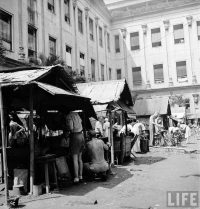Corregidor Resistance Weak. A Nishi-Nishi correspondent at the Philippine front gave the following description of a fierce raid on Corregidor:
I had the thrill of seeing parts of the fortress being blown to bits when I accompanied a squadron on a raid over the island.
Unfolding in clear panorama under me as we started out on the raid could be seen the verdant ranges of Mount Natib, Mount Samat, and Mount Mariveles lying ominously silent. To the right could be seen the shipping surface of Manila Bay, while from everywhere could be seen black columns of smoke rising from the burning remnants of enemy pillboxes. Over the roads winding through the hills, long columns of trucks, horses, and troops could be seen advancing in the wake of the Rising Sun flags. In the harbor, the masts and broken hulls of sunken ships protruded above the water.
“That’s the fortress!” the voice of the bomber commander boomed through the audiphone tube. We had at last arrived at Corregidor. Under me I could see the dark form of the island resembling a tadpole. As we circled over the fortress, the white puffs of exploding anti-aircraft shells surrounded our plane. It was as if balls of cotton were hurled at us.
“Our plane rocked heavily under the shock of the explosion. As I looked behind, I could see the remaining planes of the squadron continuing their flight in perfect formation. On the ground, the runways of the airfield and the military quarters and officers’ residences appeared like the scene afforded by a sand garden. All the while the enemy’s anti-aircraft batteries continued to pour an endless stream of shells at us.
“The sound of the explosions caused my head to ache intensely. At this moment, the wing of the commander’s plane rocked violently to the left and the right. This was the signal for the attack. Our planes began to dive madly. Bombs went sailing toward the ground.
“An instant of suspense and prayer—and then I saw the enemy’s anti-aircraft explode with a terrific concussion. Huge columns of smoke went curling up from the enemy’s quarters and residences—my heart throbbed with excitement at what I had witnessed. I as well as the other members of the squadron returned safely to the base.”
Every day the paper featured propaganda stories about the cruelty of Americans toward Filipino soldiers and of the antagonism between them.
“Even the captives’ dress shows American tyranny. American captives wear khaki uniforms and steel helmets, every soldier is shaved, and they show themselves as Yankee-like dandies, while Filipino soldiers wear worn-out, drenched uniforms. Filipinos drink water from their flasks, dividing it among them, and smoke a piece of cigarette, handing it round from one to another, while some of the Americans kick them down from a truck in order to get their seats or keep a can of milk secretly in their pockets. They don’t give it to those who happen to be sick or wounded. They are all selfish.”
When I showed the article to Pura, my Filipina friend, she laughed and exclaimed: “My goodness, how stupid these Japanese are! No Filipino will ever believe that! They know how soft the Americans are! Why, they cant even bear to watch us beat our horses!”
Old-timers who had lived in the Philippines knew this to be true. Every time a cochero driver on the street started to beat his tiny Mongolian pony, an American would stop him and threaten him with police action.
